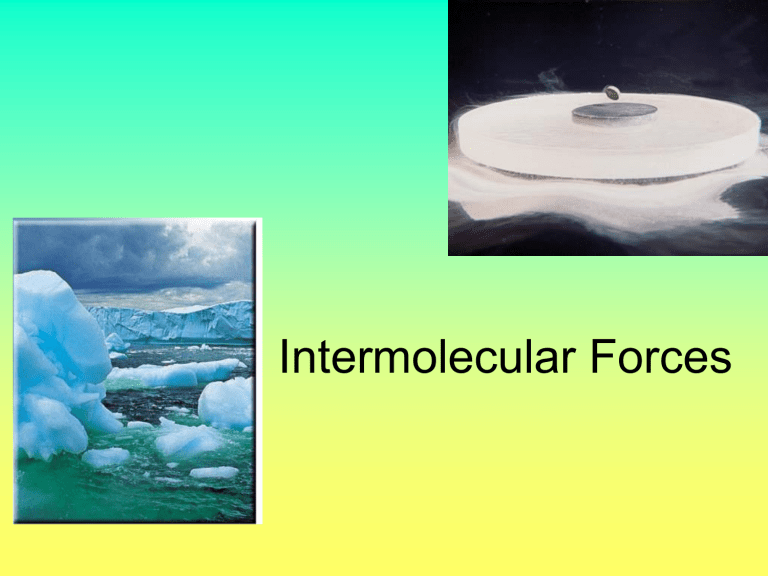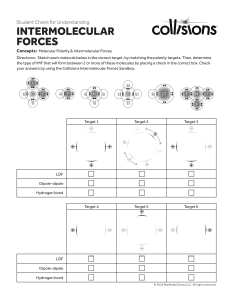
Intermolecular Forces A phase is a homogeneous part of the system in contact with other parts of the system but separated from them by a well-defined boundary. 2 Phases Solid phase - ice Liquid phase - water 11.1 Intermolecular Forces Intermolecular forces are attractive forces between molecules. Intramolecular forces hold atoms together in a molecule. Intermolecular vs Intramolecular • 41 kJ to vaporize 1 mole of water (inter) • 930 kJ to break all O-H bonds in 1 mole of water (intra) “Measure” of intermolecular force Generally, intermolecular forces are much weaker than intramolecular forces. boiling point melting point DHvap DHfus DHsub 11.2 Types of Intermolecular Forces 1. Hydrogen Bond (strongest) The hydrogen bond is a special dipole-dipole interaction between the hydrogen atom in a polar N-H, O-H, or F-H bond and an electronegative O, N, or F atom. IT IS NOT A BOND. A H…B or A H…A A & B are N, O, or F 11.2 Hydrogen Bond 11.2 Why is the hydrogen bond considered a “special” dipole-dipole interaction? Decreasing molar mass Decreasing boiling point 11.2 Types of Intermolecular Forces 2. Ion-Dipole Forces Attractive forces between an ion and a polar molecule Ion-Dipole Interaction 11.2 11.2 Types of Intermolecular Forces 3. Dipole-Dipole Forces Attractive forces between polar molecules Orientation of Polar Molecules in a Solid 11.2 Types of Intermolecular Forces 4. Dispersion Forces – van der Waals forces/London forces (weakest) Attractive forces that arise as a result of temporary dipoles induced in atoms or molecules ion-induced dipole interaction dipole-induced dipole interaction 11.2 Intermolecular Forces 4. Dispersion Forces Continued Polarizability is the ease with which the electron distribution in the atom or molecule can be distorted. Polarizability increases with: • greater number of electrons • more diffuse electron cloud Dispersion forces usually increase with molar mass. 11.2 What type(s) of intermolecular forces exist between each of the following molecules? HBr HBr is a polar molecule: dipole-dipole forces. There are also dispersion forces between HBr molecules. CH4 CH4 is nonpolar: dispersion forces. S SO2 SO2 is a polar molecule: dipole-dipole forces. There are also dispersion forces between SO2 molecules. 11.2 Assignment Cite the properties of liquids and give a real-life application of them. Properties of Liquids Surface tension is the amount of energy required to stretch or increase the surface of a liquid by a unit area. Strong intermolecular forces High surface tension 11.3 Properties of Liquids Cohesion is the intermolecular attraction between like molecules Adhesion is an attraction between unlike molecules Adhesion attracted to glass Cohesion attracted to each other 11.3 Properties of Liquids Viscosity is a measure of a fluid’s resistance to flow. Strong intermolecular forces High viscosity 11.3 Water is a Unique Substance Maximum Density 40C Density of Water Ice is less dense than water 11.3






